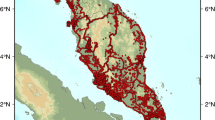Precise information of geoid undulations is essential for obtaining the orthometric heights from Global Positioning System (GPS) measurements over any region; apart from providing the information of subsurface density distribution. This paper presents computation of geoid undulations over a part of southern Indian region from terrestrial gravity and elevation data using remove–restore technique that involves spherical Fast Fourier Transform (FFT) to compute ‘Stokes’ coefficients. Computed geoid undulations are compared with geoid obtained from global geopotential models such as EGM2008 and EIGEN-GRACE02S and measured GPS-levelling records at 67 locations. Statistical analysis of comparison suggests that the computed gravimetric geoid model has a good match with the geoid determined from GPS-levelling with rms of 0.1 m whereas EGM2008 has 0.46 m. The differences of GPS-levelling with EGM2008 at majority of stations fall in the range of ±0.5 m, which indicates that EGM2008 may be used for orthometric height determination with an accuracy of <0.5 m in the south Indian region and offers a reasonably good transformation platform from ellipsoid to local datum. However, local determination of geoid is necessary for better accuracy of orthometric height from GPS. The gravimetric geoid calculated from the available gravity data shows considerable improvement to the global model and can be used to achieve orthometric height with an accuracy of 0.1 m.






Similar content being viewed by others
References
Benahmed D S A 2010 Precision assessment of the orthometric heights determination in northern part of Algeria by combining the GPS data and the local geoid model; Compt. Rendus Geosci. 342 87–94.
Corchete V 2010 The high-resolution gravimetric geoid of Italy: ITG2009; J. African Earth Sci. 58 580–584.
De lacy M C, Caderot G R, Marin E, Ruiz A, Borque M J, Gil A J and Biagi L 2001 A gravimetric geoid computation and comparison with GPS results in northern andalusia (spain); Studia Geophys. Geod. 45 55–66.
Forsberg R 1992 Modelling the fine-structure of the geoid: Methods, data requirements and some results; Surv. Geophys. 14 403–418.
Forsberg R 1994 Terrain effects in Geoid computations; Lecture notes, School for the Determination and Use of Geoid, Milano.
Forsberg R and Tscherning C C 1981 The use of height data in gravity field approximation by collocation; J. Geophys. Res. 86 7843–7854.
Gravity Map of Series of India (GMSI) 2006 Gravity anomaly maps of India on 1:2 million scale published by Geological Survey of India; GSI, Hyderabad, India.
Heiskanen W A and Moritz H 1967 Physical geodesy; W H Freeman, San Francisco.
Knudsen P 1987 Estimation and modelling of the local empirical covariance function using gravity data and satellite altimeter data; J. Geophys. Res. 86 7843–7854.
Luo Z C and Chen Y Q 2002 Precise determination of Hong Kong geoid using heterogeneous data; FIG XXII International Congress, Washington D.C., USA.
Marsh J G 1979 Satellite derived gravity maps; In: A geophysical atlas for interpretation of satellite derived data, Section 2 (eds) Lowman P D and Fray H V, NASA, Greenbelt, USA.
Mishra D C and Tiwari V M 1995 An asymmetric basic lopolith below sediments in western Cuddapah basin – geophysical evidence; Proceedings of the Geological Society of India annual convention and seminar on ‘Cuddapah basin’, Tirupati, India, pp. 31–41.
Pavlis N K, Holmes S A, Kenyon S C and Factor J K 2008 An earth gravitational model to degree 2160: EGM2008; General Assembly of the European Geosciences Union, Vienna, Austria.
Reigber C, Schmidt R, Flechtner F, König R, Meyer U, Neumayer K H, Schwintzer P and Zhu S Y 2005 Earth gravity field model complete to degree and order 150 from GRACE: EIGEN-GRACE02S; J. Geodyn. 39(1) 1–10.
Singh S K, Nagarajan B and Garg P K 2007 Determination of local gravimetric geoid; Coordinates 3 14–19.
Sterzai P, Coren F, Creati N, Marson N and Maso M 2008 An improved geoid in north eastern Italy; Observing our Changing Earth International Association of Geodesy Symposia 133(2) 427–430.
Tarial J S 2010 Determination of precise geoid from terrestrial gravity field and its comparison with geoid from grace satellite gravity mission and global geopotential model; Project Report, Indian Institute of Survey and Mapping, Hyderabad, India.
Tscherning C C 2008 Geoid determination by 3D least-squares collocation; Draft version.
Tscherning C C, Forsberg R and Knudsen P 1992 Description of the GRAVSOFT package for geoid determination; Proceedings of First Continental Workshop on the Geoid in Europe, Prague, pp. 327–334.
Yilmaz I, Yilmaz M, Gullu M and Turgut B 2010 Evaluation of recent global geopotential models based on GPS-levelling data over Afyonkarahisar (Turkey); Sci. Res. Essays 5(5) 484–493.
Yoshida M and Nakakuki T 2009 Effects on the long-wavelength geoid anomaly of lateral viscosity variations caused by stiff subducting slabs, weak plate margins and lower mantle rheology; Phys. Earth Planet. Int. 172 278–288.
Acknowledgements
The authors would like tNGRI for his support and permission to publish this work. They are also thankful to C C Tscherning, for sharing GRAVSOFT and to Vagner Gonçalves for fruitful discussions. IFCPAR is acknowledged for the financial support provided through a project on Hydrology and Water Resources from Space over Indian region at NGRI.
Author information
Authors and Affiliations
Corresponding author
Rights and permissions
About this article
Cite this article
SRINIVAS, N., TIWARI, V.M., TARIAL, J.S. et al. Gravimetric geoid of a part of south India and its comparison with global geopotential models and GPS-levelling data. J Earth Syst Sci 121, 1025–1032 (2012). https://doi.org/10.1007/s12040-012-0205-7
Received:
Revised:
Accepted:
Published:
Issue Date:
DOI: https://doi.org/10.1007/s12040-012-0205-7




